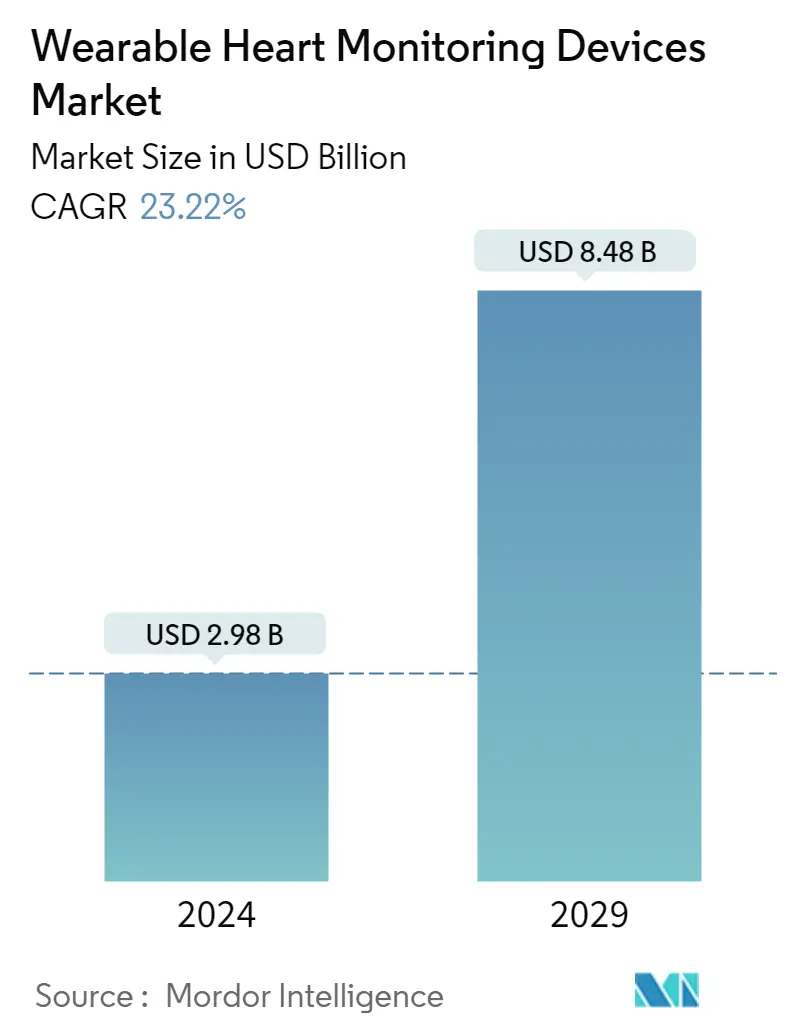Market Size of Wearable Heart Monitoring Devices Industry

| Study Period | 2019 - 2029 |
| Market Size (2024) | USD 2.98 Billion |
| Market Size (2029) | USD 8.48 Billion |
| CAGR (2024 - 2029) | 23.22 % |
| Fastest Growing Market | Asia-Pacific |
| Largest Market | North America |
| Market Concentration | Medium |
Major Players
*Disclaimer: Major Players sorted in no particular order |
Wearable Heart Monitoring Devices Market Analysis
The Wearable Heart Monitoring Devices Market size is estimated at USD 2.98 billion in 2024, and is expected to reach USD 8.48 billion by 2029, growing at a CAGR of 23.22% during the forecast period (2024-2029).
During the COVID-19 pandemic, coronavirus-infected patients were more likely to develop heart problems and vice-versa, which increased the risk. This was attributed to the rising demand for wearable heart monitoring devices, as the real-time monitoring of cardiovascular disease effectively reduced COVID-19 mortality rates. For instance, as per the article published in February 2021 in JMIR publications, wearable devices can identify COVID-19 cases earlier than traditional diagnostic methods and can help track and improve the management of the disease. Significant changes in heart rate variability (HRV) were seen before the identification of COVID-19 by nasal PCR, suggesting its predictive capacity to diagnose COVID-19 infection. However, for some patients, heart problems persisted long after the impact of COVID-19 infection. For instance, as per the article published in February 2022 in Nature journal, people who had recovered from COVID-19 showed stark increases in cardiovascular problems over the year after infection. Therefore, the awareness of wearable technology among cardiac patients is constantly rising, and the wearable heart monitoring devices market will see rapid expansion in the near future.
Certain factors that are driving the market growth include the increasing rate of heart failure, rising awareness of wearables-based cardiac monitoring, and technological advancements in wearable devices. The CDC update published in October 2022 stated that coronary heart disease is the most common type of heart disease, and around 20.1 million adults aged 20 and older have coronary artery disease (approximately 7.2%). Thus, the high burden of coronary artery disease is driving the growth of the market. Further, as per the 2022 Spotlight on Heart Failure report, more than 100,000 Canadians are diagnosed with heart failure each year. As per the same source, Heart failure is likely to cost Canada more than USD 2.8 billion a year. Therefore, the rising cases of heart failure and increasing healthcare cost demands heart monitoring devices based on wearable technology to reduce the cost and improves heart monitoring.
In addition, in January 2021, Boston Scientific acquired Preventice Solutions for USD 925 million. Preventice Solutions is a manufacturer of several wearable cardiac sensors (BodyGuardian) used for remote patient monitoring. These devices are developed for adult as well as pediatric patients. Therefore, from this acquisition, Boston Scientific expanded its business segment of core cardiac rhythm management and electrophysiology which in turn strengthened its position in this attractive market.
Moreover, in February 2021, RhythMedix launched the newest-generation wearable ECG monitor named 'RhythmStar'. This device has built-in cellular connectivity which can collect ECG recordings by itself and send data wirelessly to physicians without the use of a phone. This simplified and time-saving approach may entice more customers and raise their market potential. Thus, the rise in the adoption of advanced technology in wearable devices comprises benefits that help patients and physicians to manage heart problems in a better way, thereby contributing to market growth.
Thus, due to the rise in cardiac complications, and the increase in heart-monitoring wearable product launches, the wearable heart-monitoring devices market is anticipated to witness growth over the forecast period. However, privacy & security issues of wearable devices and stringent rules and regulatory policies are major factors hindering the wearable heart monitoring devices market's growth.
Wearable Heart Monitoring Devices Industry Segmentation
As per the scope of this report, wearable heart monitoring devices are usually worn on the chest or wrist. These devices contain smart sensors that can record both heart rhythm and heart rate, as well as can connect to mobile applications for data reporting. The Wearable Heart Monitoring Devices Market is Segmented by Product (Electric Pulse-based Product and Optical Technology-based Product), Device Type (Diagnostic & Monitoring Devices and Therapeutic Devices), Application (Sports & Fitness, Remote Patient Monitoring, and Home Healthcare), and Geography (North America, Europe, Asia-Pacific, Middle East and Africa, and South America). The market report also covers the estimated market sizes and trends for 17 different countries across major regions, globally. The report offers the value (in USD million) for the above segments.
| By Product | |
| Electric Pulse-based Product | |
| Optical Technology-based Product |
| By Device Type | |
| Diagnostic & Monitoring Devices | |
| Therapeutic Devices |
| By Application | |
| Sports & Fitness | |
| Remote Patient Monitoring | |
| Home Healthcare |
| Geography | ||||||||
| ||||||||
| ||||||||
| ||||||||
| ||||||||
|
Wearable Heart Monitoring Devices Market Size Summary
The wearable heart monitoring devices market is poised for significant growth, driven by the increasing prevalence of cardiovascular diseases and the rising awareness of wearable technology among cardiac patients. The demand for these devices surged during the COVID-19 pandemic, as they proved effective in real-time monitoring of cardiovascular health, thereby reducing mortality rates associated with the virus. The market is further bolstered by technological advancements and strategic acquisitions, such as Boston Scientific's acquisition of Preventice Solutions, which expanded its cardiac rhythm management segment. The introduction of innovative products like RhythMedix's RhythmStar, with its built-in cellular connectivity, highlights the industry's focus on enhancing patient and physician experiences in managing heart health.
North America is expected to hold a significant share of the market, supported by the high incidence of cardiovascular diseases and the presence of major industry players. The region's growth is further fueled by government initiatives and the launch of advanced wearable devices, such as Samsung Canada's Galaxy Watch5, which incorporates cutting-edge sensor technology. The market's competitive landscape is characterized by the presence of key players like Medtronic, iRhythm Technologies, and Koninklijke Philips, who are actively engaging in strategic initiatives to capture market share. Despite challenges such as privacy concerns and regulatory hurdles, the market is anticipated to expand, driven by the increasing adoption of optical technology-based products and the ongoing development of innovative wearable solutions.
Wearable Heart Monitoring Devices Market Size - Table of Contents
-
1. MARKET DYNAMICS
-
1.1 Market Overview
-
1.2 Market Drivers
-
1.2.1 Increasing Rate of Heart Failure
-
1.2.2 Rising Awareness of Wearables-based Cardiac Monitoring
-
1.2.3 Technological advancements in Wearable Devices
-
-
1.3 Market Restraints
-
1.3.1 Privacy and Security Issue of Wearable Devices
-
1.3.2 Stringent Rules & Regulatory Policy
-
-
1.4 Porter's Five Forces Analysis
-
1.4.1 Threat of New Entrants
-
1.4.2 Bargaining Power of Buyers/Consumers
-
1.4.3 Bargaining Power of Suppliers
-
1.4.4 Threat of Substitute Products
-
1.4.5 Intensity of Competitive Rivalry
-
-
-
2. MARKET SEGMENTATION (Market Size by Value - USD million)
-
2.1 By Product
-
2.1.1 Electric Pulse-based Product
-
2.1.2 Optical Technology-based Product
-
-
2.2 By Device Type
-
2.2.1 Diagnostic & Monitoring Devices
-
2.2.2 Therapeutic Devices
-
-
2.3 By Application
-
2.3.1 Sports & Fitness
-
2.3.2 Remote Patient Monitoring
-
2.3.3 Home Healthcare
-
-
2.4 Geography
-
2.4.1 North America
-
2.4.1.1 United States
-
2.4.1.2 Canada
-
2.4.1.3 Mexico
-
-
2.4.2 Europe
-
2.4.2.1 Germany
-
2.4.2.2 United Kingdom
-
2.4.2.3 France
-
2.4.2.4 Italy
-
2.4.2.5 Spain
-
2.4.2.6 Rest of Europe
-
-
2.4.3 Asia-Pacific
-
2.4.3.1 China
-
2.4.3.2 Japan
-
2.4.3.3 India
-
2.4.3.4 Australia
-
2.4.3.5 South Korea
-
2.4.3.6 Rest of Asia-Pacific
-
-
2.4.4 Middle East and Africa
-
2.4.4.1 GCC
-
2.4.4.2 South Africa
-
2.4.4.3 Rest of Middle East and Africa
-
-
2.4.5 South America
-
2.4.5.1 Brazil
-
2.4.5.2 Argentina
-
2.4.5.3 Rest of South America
-
-
-
Wearable Heart Monitoring Devices Market Size FAQs
How big is the Wearable Heart Monitoring Devices Market?
The Wearable Heart Monitoring Devices Market size is expected to reach USD 2.98 billion in 2024 and grow at a CAGR of 23.22% to reach USD 8.48 billion by 2029.
What is the current Wearable Heart Monitoring Devices Market size?
In 2024, the Wearable Heart Monitoring Devices Market size is expected to reach USD 2.98 billion.

